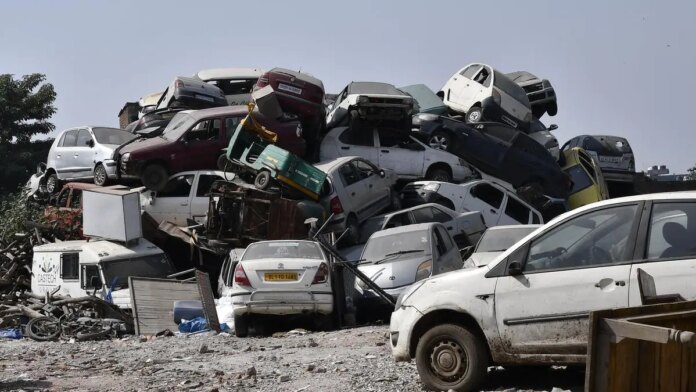
Old unused vehicles at one of the Junk Yard, where large numbers of cars can be seen on top of each other at Subhash Nagar area in South Delhi Municipal Corporation, in West Delhi | Photo Credit: SHIV KUMAR PUSHPAKAR
Despite India boasting a network of 171 ‘approved’ Registered Vehicle Scrapping Facilities (RVSFs) across 20 States and Union Territories—with 101 already operational—public enthusiasm for vehicle scrappage remains remarkably low.
According to statistics gleaned from Ministry of Road Transport and Highways (MoRTH), since April 2022, a mere 2.5 lakh vehicles have been scrapped at these centers, a stark contrast to the estimated three crore vehicles nearing the end of their lives.
A primary reason for this reluctance stems from the unwillingness of carmakers to offer significant discounts, with industry insiders explaining that a 10 per cent discount on new vehicle purchases in exchange for a scrappage certificate is simply not viable.
The government’s Vehicle Scrappage Policy, officially launched in March 2021 with phased implementation beginning April 1, 2022, aims to modernize the vehicle fleet and promote environmental benefits by phasing out old and unfit vehicles, including government and private fleets.
However, the policy faces considerable headwinds from private owners. Industry insiders say that many individuals harbor a strong emotional attachment to their first or gifted cars, making them unwilling to voluntarily scrap their vehicles or utilize the scheme when buying new ones.
This sentiment was dramatically underscored during the Delhi government’s recent ban on older petrol and diesel vehicles, which triggered such public backlash that Chief Minister Rekha Gupta was compelled to put the rule on hold.
“In India, a car is a valuable possession, often bought with hard-earned money over a lifetime. Many families develop a deep bond with their first cars and diligently maintain them. That’s why many owners are reluctant to go to scrappage centers, unlike in Western countries,” explained a Delhi-based auto expert.
Another critical factor contributing to this inertia is India’s low per capita income coupled with the escalating cost of vehicles, making new car purchases increasingly unaffordable, even for entry-level small cars. The drastic fall in small car sales over the last five to six years illustrates this affordability crisis, largely due to price hikes driven by stricter regulations like BS6 norms and mandatory airbags.
Rahul Bharti, Senior Executive Officer, Corporate Affairs, Maruti Suzuki India, recently highlighted this, stating, “Historically, passenger vehicle sales used to grow at 1.5 times the GDP growth. But, now even after 6.5 percent GDP growth, the car market is nearly flattish. This is because the once mass small car segment is not participating in the growth at all. This is clearly an affordability issue. Since 2019, the industry’s entry-level price point has jumped by over 70 percent, largely driven by stricter regulations, and the sales of smaller cars have fallen by over 70 percent.”
Adding to the challenge, the availability and accessibility of RVSFs remain problematic. While MoRTH reports 101 operational RVSFs and over 50 more under construction, their geographical distribution and operational status vary significantly.
Uttar Pradesh leads with 79 centers, but only 29 are operational. Haryana has 16 operational centers, while Gujarat has six. Interestingly, Delhi, despite its recent push to restrict older vehicles, has only one RVSF, which is not yet functional. This forces Delhi residents interested in scrapping their vehicles to transport them to facilities in neighboring Uttar Pradesh (Noida, Ghaziabad) or Haryana.
This creates a catch-22 situation for owners: they desire maximum discounts for scrapping their old vehicles and purchasing new ones, but few Original Equipment Manufacturers (OEMs) are offering substantial incentives.
Only a handful of mass-market carmakers like Maruti Suzuki India, Tata Motors, Hyundai Motor India, Kia India, and Toyota Kirloskar Motor, along with luxury carmaker Mercedes-Benz, are offering a maximum discount of ₹25,000.
An industry insider stated, “The discounts are nominal, and only a few companies are offering them. No OEM can give discounts up to 10 per cent and can offer only up to 3 percent or a maximum of ₹25,000 on a car in exchange for a scrappage certificate.”
This limited financial incentive, combined with emotional attachment and affordability concerns, largely explains the lagging adoption of India’s vehicle scrappage policy.a new vehicle, which only a few original equipment manufacturers (OEMs) including Maruti Suzuki India, Tata Motors, Hyundai Motor India, Kia India, and Toyota Kirloskar Motor in mass market cars and Mercedes-Benz in luxury car makers are offering of maximum ₹25,000.
“The discounts are nominal and only a few companies are offering. No OEM can give discounts up to 10 per cent and can offer only up to 3 per cent or a maximum of ₹25,000 on a car in exchange of scrappage certificate,” said an industry veteran.
Published on July 6, 2025




